Our visit to Winton in Western Queensland, has been somewhat different to what we expected. But then we really didn't have BIG expectations! We just hadn't thought enough about the fact that Winton was going to be the first rural town of our travels in Western Queensland, that did not have mining to boost the economy. We had read of the 'Waltzing Matilda Centre' and that dinosaur bones had been discovered in the area. Winton is a Queensland outback town, which we suspect would have become even more derelict without the 'Waltzing Matilda Centre' and the discovery of those dinosaur bones. These two tourist attractions have made a huge difference in keeping the town 'alive'! A resident has been suitably recognised, on one of the memorials in the main street, for his initiative in forming the town's tourism committee. There is the odd nicely kept home in the town, but there are lots of homes that are very old and have an 'unloved' look. The climate is harsh. Their rain is from the wet season, as is all of Queensland, and the whole area has been drought affected for many years.
It is all grazing country and one can see the potential of the land, if only it would rain! The same old story for those living on the land and of course for the businesses associated with primary industry. Over the three days we were in Winton there was lots of movement of cattle. Lots of road trains, cattle in yards and we also saw a cattle train heading to Winton on our way to Longreach. The caravan park would have battled to be even close to 3 star and with a north easterly wind, it was not nice at all. There was plenty of dirt and dust swirling around the park and the odd willy willy! Their water supply is artesian and although we have since been told, it tastes very nice after it has been sitting for a while, the smell was enough for us! It was awful! The water from the artesian bores in Winton is between 80 and 90 degrees celsius. It is put through heat exchangers and the water is then pumped into the town supply at approximately 55 - 60 degrees. The first heat exchanger purchased by the town is now in the Museum.
The cost was $139,428.00 and it commenced operation in February 1988. It was interesting to read at the Museum, that in the early years there was an open channel at the back of the town, into which the artesian water flowed. When the 'Swaggies' came into town, they would buy a piece of corn beef from the butcher, put it into their billy can which had holes in it, and place it in the channel. When they came back later in the day their meat was cooked. When we arrived on Saturday, who should be directly opposite us in the 'Matilda Caravan Park', but Greg and Irene Trevaskis. Greg and Irene are great friends of my brother Smock and his wife Val, and Greg worked at the Geraldton Building Co for many years. Greg couldn't remember the couple of years I worked there, before going to the back blocks of Yuna! So it was great to reminisce of 'the good old days of GBC'! On our last night of having a drink together, Greg and Irene's dog Stephie, created chaos! She is not that fond of cats and they stir her up a bit! I happened to be rubbing her head and talking to her about Val and Smock's little dog Zac.
Val has looked after Stephie at times for Greg and Irene. Stephie was tied to the front of the van, so she had come through under our table that clips to the side of the van.The table was an innovative idea of Mark, the Aussiewide salesman, who was quite chuffed with this feature, when we purchased the van. Well this cat shot through between us all and Stephie took off after it! In a split second the drinks and nibbles were on the ground, the table was hanging off the side of the van and the screws fixing the leg of the table were out! What a commotion! Of course her lead pulled her up with a jolt! We were beside ourselves and when we looked down, the bowl of peanuts was sitting neatly on top of the empty plate. Not one had spilt! We were putting the call out for the carpenter back in Geraldton. Hopefully though, Pete has done a good enough repair job! He has had the super glue out! The 'Waltzing Matilda Centre' is definitely a 'Must See'. The theatre with the old 'swaggies' face projected into the Billabong is so good.
After us being so disappointed with John Williamson's concert in Tamworth, it just happens to be his recording of 'Waltzing Matilda', that is played in this 'Billabong Theatre'. Have to give him a BIG tick for that one. It was all very moving.There are many 'Ambassadors' of the Centre and they all have put together a little spiel. All of these have been placed on a wall. These words are part of what Slim Dusty has written:
In an era of disappearing national culture, the 'Waltzing Matilda Centre' stands as a centre of Australian culture and heritage. The song itself is a symbol of our national spirit, a rallying point for displaying and preserving a national culture which is unique to our country Australia.John Willimason says: Waltzing Matilda and Banjo Paterson together surely are the foundation of all Australian songs and music. It is therefore wonderful that the community of Winton and the Australian people have built a lasting and substantial monument to this icon. A nation that loses touch with its roots, loses its identity and becomes too vulnerable to outside forces. Waltzing Matilda stirs the heart deep within the ordinary Australian. Whether Banjo intended it or not I believe it is the classic battlers anthem. There will be always battlers in this isolated, huge dry continent. The music to 'Waltzing Matilda' was first played in Winton. Christina Macpherson, whose family owned Dagworth Station near Winton, heard a tune performed by a band at the Warrnambool Races in Victoria, in April 1894. Whilst visiting the Winton district the following year, she performed a version of that tune at a gathering of friends and relatives, which included Banjo Paterson. It is written that after hearing the Scottish tune, Banjo put the words together and called it 'Waltzing Matilda'. After its first public performance, the song quickly became popular and was soon performed throughout the district.The'Hologram' is also excellent and it sure makes you feel very proud to be an Australian! It is so clever how these holograms are put together. We had never seen one until we started 'Travelling Oz'. Our visit to the 'Australian Age of Dinosaurs' was far more than we expected. So much so, that Peter has commented that 'I appear to really be getting into this dinosaur thing'! Dave and Judy Elliott found huge bones on their cattle station 22 kms east of Winton in the 1990's. They had found plenty of small bones over many years, but nothing as large as what was found then. Dave sent them off to Brisbane to the Museum, but soon realised that for anything major to happen, he would have to become more involved. They published their first Annual in 2003 and on the 30th July 2008, the foundation stone for the 'Museum of Natural History' was officially unveiled. It took until 2012 for the building to become a reality at a cost of $2.5 million. It has been constructed on the edge of a huge mesa near Winton known as 'The Jump-Up'. $1 million came from the Federal Government and the other from Corporate Australia. They are very excited because the building has been short listed to the top 12 in the 'Display' category of the 'World Architectural Festival', which will be judged in October this year. The Architectural Company actually donated their services for the building of the 'Reception Centre' and the principal of the company made the following statement about the project.....we are gob-smacked at what has been achieved through the passion and determination of a small community and we are just so proud to be involved. The laboratory possibly opened earlier. Fo two weeks every year, volunteers come and assist with the excavation of dinosaur fossils. The bones that are found are prepared with the appropriate casing around the stone,, and then each is carefully labled. Each new find has a new name. Their main treasures to date are two dinosaurs named Banjo and Matilda. The 'Pete Site' that was found in 2013, is labelled 'Very Interesting" in the laboratory! They have no idea what dinosaur 'Pete' is yet. He is still a mystery! What they have stored, will take at least five years for them to grind the stone from. We asked the difference between the 'Riversleigh' site and the 'Winton' one. Just to be sure that we weren't getting totally confused with these dinosaur fossils! What we thought we had learnt at Mt Isa about 'Riversleigh' was right. The fossils there are in a sandstone that can be treated with an acid. At Winton the rock has to be ground off. The grinding is undertaken by 'Volunteers'. Interested people can become involved by doing a 10 day course at their own cost of $55.00 per day. After you have completed the course, they welcome you back there any time for any amount of time, to sit and grind stone from the fossils. There would have been about 8 volunteers grinding away during our tour. This laboratory, which is the bone preparation facility, has the largest collection of Australian dinosaur fossils in the world! We also visited a 'Heritage Truck Museum'. Lots of trucks to see and lots and lots of trucks still to be restored. There is a huge yard out the back which is full of 'old vehicles'. During a short film at the Museum, it was advertised that they would be grateful of any assistance from 'Volunteers' travelling through! For anyone 'Looking for something to do' as they 'Travel Oz', there is plenty that can be found! Near the 'Heritage Truck Museum' there is a 'Musical Fence', so we checked that out as well. It is another tourism initiative that attracted considerable funding and it brought people together for an official opening. It was quite an interesting and different playground within this small community. We had a drink at the historic 'North Gregory Hotel'. It has burnt down twice and in 1955 the local Shire rebuilt it. We thought that was very interesting! The Shire building 'A Pub'! Especially as there are at least three other hotels in the town and a RSL club and a Bowling Club. We went out to the 'Pelican Water Hole Cairn', the site of the first settlement of the town. In the early years of establishing the town it was flooded, so they moved to a higher site. The opal mining industry also flourishes in Winton, and has for more than a century. Some of the best boulder opal has been found from claims within the Winton Shire. So..... we couldn't leave Winton without having a bit of a look at the opals! Fiona and Jasmine have birthdays this month. So maybe a daughter will have something special when we get home. And maybe I have another to add to my collection!We think after three nights in Winton we have seen all there is to see in the town and injected a few dollars into the community. It has all been very interesting and it was great to spend some time with Greg and Irene. They were also headed to Longreach, so we intend to catch up again there.
In an era of disappearing national culture, the 'Waltzing Matilda Centre' stands as a centre of Australian culture and heritage. The song itself is a symbol of our national spirit, a rallying point for displaying and preserving a national culture which is unique to our country Australia.John Willimason says: Waltzing Matilda and Banjo Paterson together surely are the foundation of all Australian songs and music. It is therefore wonderful that the community of Winton and the Australian people have built a lasting and substantial monument to this icon. A nation that loses touch with its roots, loses its identity and becomes too vulnerable to outside forces. Waltzing Matilda stirs the heart deep within the ordinary Australian. Whether Banjo intended it or not I believe it is the classic battlers anthem. There will be always battlers in this isolated, huge dry continent. The music to 'Waltzing Matilda' was first played in Winton. Christina Macpherson, whose family owned Dagworth Station near Winton, heard a tune performed by a band at the Warrnambool Races in Victoria, in April 1894. Whilst visiting the Winton district the following year, she performed a version of that tune at a gathering of friends and relatives, which included Banjo Paterson. It is written that after hearing the Scottish tune, Banjo put the words together and called it 'Waltzing Matilda'. After its first public performance, the song quickly became popular and was soon performed throughout the district.The'Hologram' is also excellent and it sure makes you feel very proud to be an Australian! It is so clever how these holograms are put together. We had never seen one until we started 'Travelling Oz'. Our visit to the 'Australian Age of Dinosaurs' was far more than we expected. So much so, that Peter has commented that 'I appear to really be getting into this dinosaur thing'! Dave and Judy Elliott found huge bones on their cattle station 22 kms east of Winton in the 1990's. They had found plenty of small bones over many years, but nothing as large as what was found then. Dave sent them off to Brisbane to the Museum, but soon realised that for anything major to happen, he would have to become more involved. They published their first Annual in 2003 and on the 30th July 2008, the foundation stone for the 'Museum of Natural History' was officially unveiled. It took until 2012 for the building to become a reality at a cost of $2.5 million. It has been constructed on the edge of a huge mesa near Winton known as 'The Jump-Up'. $1 million came from the Federal Government and the other from Corporate Australia. They are very excited because the building has been short listed to the top 12 in the 'Display' category of the 'World Architectural Festival', which will be judged in October this year. The Architectural Company actually donated their services for the building of the 'Reception Centre' and the principal of the company made the following statement about the project.....we are gob-smacked at what has been achieved through the passion and determination of a small community and we are just so proud to be involved. The laboratory possibly opened earlier. Fo two weeks every year, volunteers come and assist with the excavation of dinosaur fossils. The bones that are found are prepared with the appropriate casing around the stone,, and then each is carefully labled. Each new find has a new name. Their main treasures to date are two dinosaurs named Banjo and Matilda. The 'Pete Site' that was found in 2013, is labelled 'Very Interesting" in the laboratory! They have no idea what dinosaur 'Pete' is yet. He is still a mystery! What they have stored, will take at least five years for them to grind the stone from. We asked the difference between the 'Riversleigh' site and the 'Winton' one. Just to be sure that we weren't getting totally confused with these dinosaur fossils! What we thought we had learnt at Mt Isa about 'Riversleigh' was right. The fossils there are in a sandstone that can be treated with an acid. At Winton the rock has to be ground off. The grinding is undertaken by 'Volunteers'. Interested people can become involved by doing a 10 day course at their own cost of $55.00 per day. After you have completed the course, they welcome you back there any time for any amount of time, to sit and grind stone from the fossils. There would have been about 8 volunteers grinding away during our tour. This laboratory, which is the bone preparation facility, has the largest collection of Australian dinosaur fossils in the world! We also visited a 'Heritage Truck Museum'. Lots of trucks to see and lots and lots of trucks still to be restored. There is a huge yard out the back which is full of 'old vehicles'. During a short film at the Museum, it was advertised that they would be grateful of any assistance from 'Volunteers' travelling through! For anyone 'Looking for something to do' as they 'Travel Oz', there is plenty that can be found! Near the 'Heritage Truck Museum' there is a 'Musical Fence', so we checked that out as well. It is another tourism initiative that attracted considerable funding and it brought people together for an official opening. It was quite an interesting and different playground within this small community. We had a drink at the historic 'North Gregory Hotel'. It has burnt down twice and in 1955 the local Shire rebuilt it. We thought that was very interesting! The Shire building 'A Pub'! Especially as there are at least three other hotels in the town and a RSL club and a Bowling Club. We went out to the 'Pelican Water Hole Cairn', the site of the first settlement of the town. In the early years of establishing the town it was flooded, so they moved to a higher site. The opal mining industry also flourishes in Winton, and has for more than a century. Some of the best boulder opal has been found from claims within the Winton Shire. So..... we couldn't leave Winton without having a bit of a look at the opals! Fiona and Jasmine have birthdays this month. So maybe a daughter will have something special when we get home. And maybe I have another to add to my collection!We think after three nights in Winton we have seen all there is to see in the town and injected a few dollars into the community. It has all been very interesting and it was great to spend some time with Greg and Irene. They were also headed to Longreach, so we intend to catch up again there.
16 Photos

 Winton, Queensland, Australia
Winton, Queensland, Australia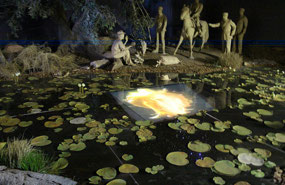
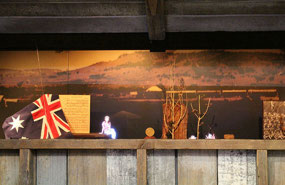
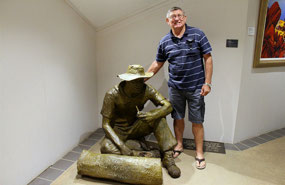
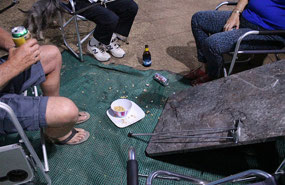
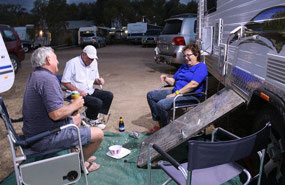
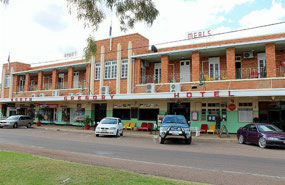
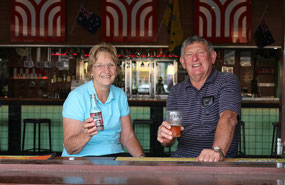
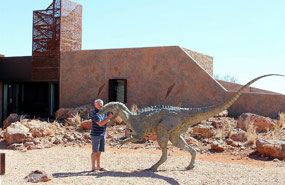
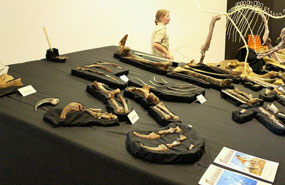
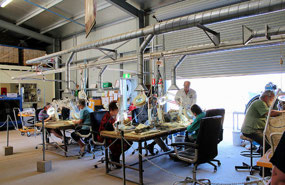

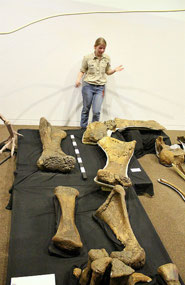
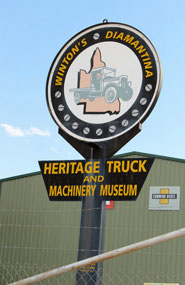
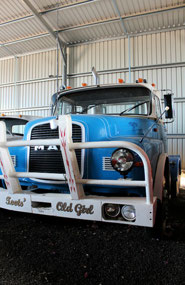
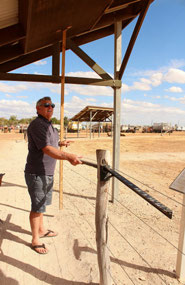
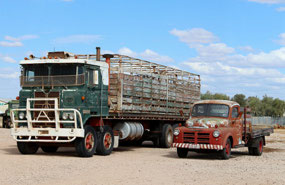
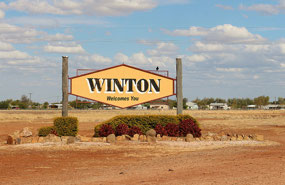
2025-05-22